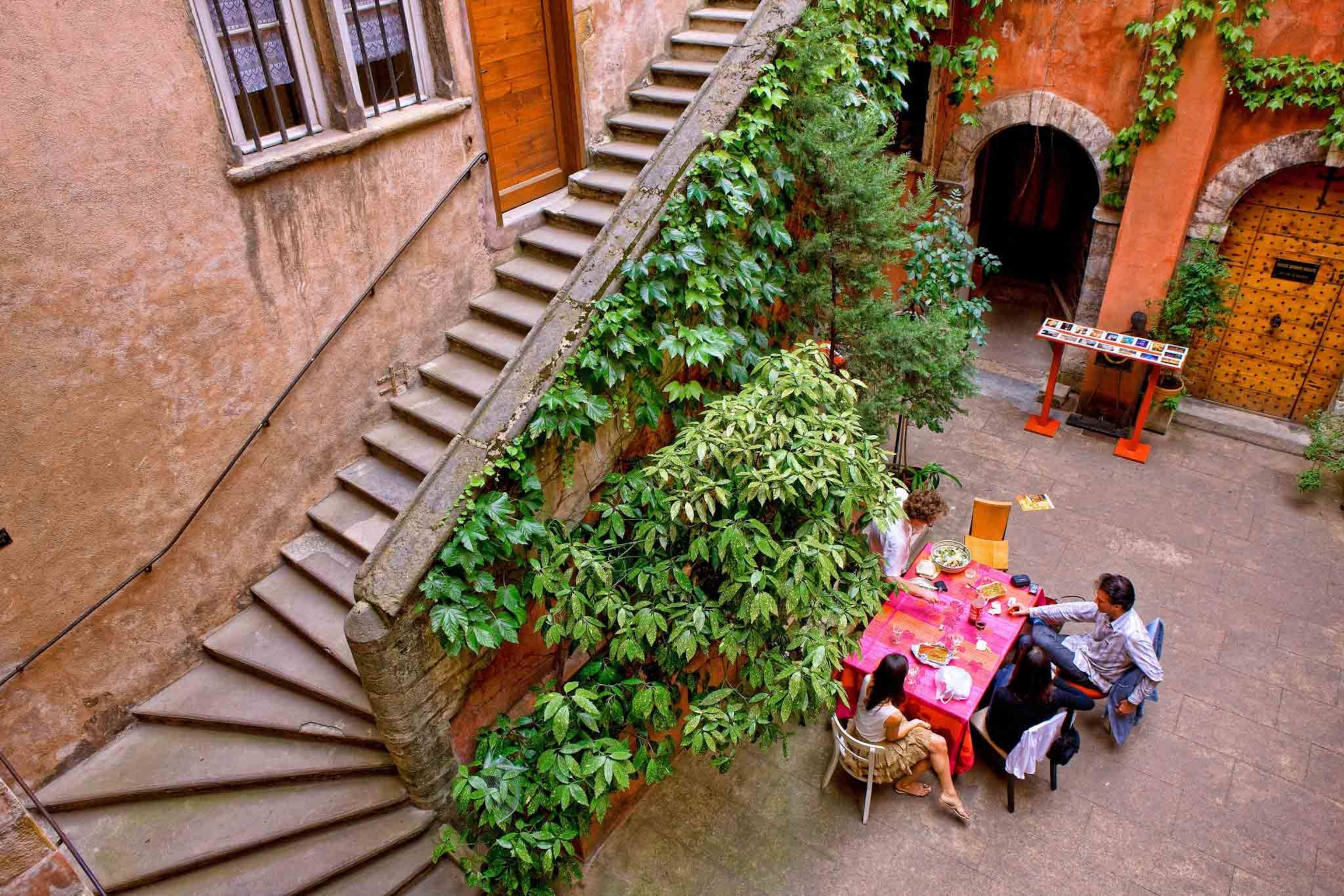
What secrets lie beneath Lyon?
A labyrinth of corridors conceals a complicated past in France.
Tucked between Lyon’s old-town streets and its Croix-Rousse neighborhood, the traboules—a vast network of around 400 hidden corridors, passages, and stairwells—have borne witness to historic moments from the silk trade to French Resistance meetings in World War II.
Tour guide Veronique Destombes has lived in the city for over 30 years and knows just where to dip into discreet doors, to climb stairs, and venture down subtly marked traboules to explore the 50 pathways still open to the public. Each route has its own distinct pastel color and unique architectural element, such as towering staircases, vaulted ceilings, or detailed, Renaissance arches.
As we walk along Rue du Boeuf, Destombes weaves tales of how the canuts, or Lyonnaise silk workers, used the traboules to transport the fabrics across the city safely, avoiding rain and dirt. In the 1800s, the traboules played a key role during the Canut revolts—one of the first documented uprisings of Europe’s Industrial Revolution. Exploited silk workers used the walkways to sneak into the city center and take over the town. During World War II, the French Resistance used the network to evade the Nazis. Runners would slip into the clandestine passageways to avoid capture and could use the alleys’ double doors to share important messages without suspicion.
In love with Lyon? This nearby region may be your next travel obsession.
Many of the traboules are now on private property, used only by residents. In the 1990s, Lyon city officials agreed to pay for maintenance and restoration of traboules that residents keep open to the public from morning until evening.
Where to find traboules
With a bit of detective work, savvy travelers can find their own moments of quiet in the traboules spread across the city. In Old Lyon, entrances are marked with shield-shaped bronze plaques, while in Croix-Rousse, a lion’s head on a blue marker guides the way. Here are four traboules worth sleuthing for.
Traboule de la Cour des Voraces
A sanctuary to silk workers during the Canut revolts, Traboule de la Cour des Voraces preserves canut history with its famous six-floor stairway façade—one of the oldest in the city—and a memorial that reads: “In the Cour des Voraces, a hive of the silk industry, canuts fought for their living conditions and their dignity.” The historical passage begins at 9 Place Colbert and 14 bis montée Saint-Sébastien.

La Longue Traboule
At 54 Rue Saint-Jean, search for the green door and an engraving reading “La Longue Traboule” to find the longest traboule in Old Lyon. Stretching to 27 Rue du Bœuf, the walkway crosses through five courtyards and tunnels under four buildings. It’s one of the few traboules still used daily by locals to navigate Old Lyon.
Traboule de la Tour Rose
Enter at 16 Rue du Bœuf to discover a rose-tinted watchtower, complete with spiraling staircase, while traversing the Traboule de la Tour Rose. The stairs are closed to the public, but the delicate colors of the courtyard and Renaissance-style windows of the tower create a picturesque scene.
Traboule de Maison Brunet
Connecting 10 Rue Rivet with 5 Place Rouville, and 12 Rue Rivet with 6 Place Rouville, this traboule leads travelers to Maison Brunet, a structure built with references to periods of time—365 windows (days in a year), 52 apartments (weeks in a year), seven floors (days in a week), and four entrances (seasons in a year). During the Canut revolt, soldiers would use the numerous windows to hurl fireballs at the national guard.
Related Topics
You May Also Like
Go Further
Animals
- He’s called ‘omacha,’ a dolphin that transforms into a man. Why?He’s called ‘omacha,’ a dolphin that transforms into a man. Why?
- Behind the scenes at America’s biggest birding festivalBehind the scenes at America’s biggest birding festival
- How scientists are piecing together a sperm whale ‘alphabet’How scientists are piecing together a sperm whale ‘alphabet’
- Orangutan seen using plants to heal wound for first timeOrangutan seen using plants to heal wound for first time
Environment
- He’s called ‘omacha,’ a dolphin that transforms into a man. Why?He’s called ‘omacha,’ a dolphin that transforms into a man. Why?
- The northernmost flower living at the top of the worldThe northernmost flower living at the top of the world
- This beautiful floating flower is wreaking havoc on NigeriaThis beautiful floating flower is wreaking havoc on Nigeria
- What the Aral Sea might teach us about life after disasterWhat the Aral Sea might teach us about life after disaster
- What La Palma's 'lava tubes' tell us about life on other planetsWhat La Palma's 'lava tubes' tell us about life on other planets
History & Culture
- This thriving society vanished into thin air. What happened?This thriving society vanished into thin air. What happened?
- These were the real rules of courtship in the ‘Bridgerton’ eraThese were the real rules of courtship in the ‘Bridgerton’ era
Science
- Is the 5-second rule true? Science finally has an answer.
- Science
- Gory Details
Is the 5-second rule true? Science finally has an answer. - E-bikes are good for the environment—but what about your health?E-bikes are good for the environment—but what about your health?
- Why trigger points cause so much pain—and how you can relieve itWhy trigger points cause so much pain—and how you can relieve it
Travel
- The story of this French village is set in stone — literallyThe story of this French village is set in stone — literally
- How to spend a long weekend in Zagreb, Croatia
- Paid Content
How to spend a long weekend in Zagreb, Croatia - The best LGBTQ-friendly destinations for every travelerThe best LGBTQ-friendly destinations for every traveler




